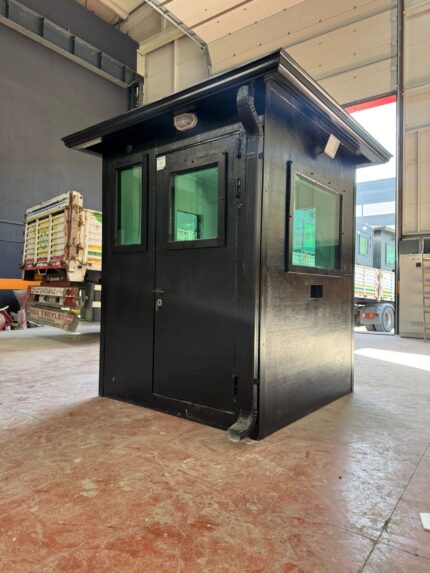Ballistic guardhouses, also known as sentry booths or bullet-resistant guard posts, are becoming an essential part of modern security infrastructures. These structures are designed to protect personnel from direct fire threats while enabling them to perform observation and control tasks effectively. A well-designed ballistic guardhouse not only provides protection but also balances visibility, communication, ergonomics, and climate control. In this article, we will explore what ballistic guardhouses are, where they are used, the materials involved, protection and blast resistance, design considerations, maintenance, and purchasing guidelines.
What is a ballistic guardhouse and where is it used?
A ballistic guardhouse is a fixed or portable armored shelter commonly installed at entry/exit control points, military bases, embassies, government institutions, industrial sites, or large residential/academic campuses. Its primary function is to safeguard guards and personnel against firearm threats, shrapnel, and explosive fragments while ensuring secure observation and communication.
Materials used and their pros/cons
Armored steel panels
- Pros: Durable, cost-effective, high resistance to penetration.
- Cons: Heavy, conducts heat, risk of spall (fragmentation) unless coated.
Ceramic plates
- Pros: Effective against high-caliber rounds, dissipates energy well.
- Cons: Brittle; requires replacement after impact.
Composite / UHMWPE (ultra-high molecular weight polyethylene)
- Pros: Lightweight, excellent energy absorption.
- Cons: Sensitive to temperature/UV exposure; needs proper protection.
Layered hybrid systems (steel + ceramic + composites)
- Pros: Optimized balance between weight and ballistic resistance.
The choice depends on the expected threat level, whether the unit should be mobile or fixed, and budget considerations.
Protection levels and standards
Ballistic performance is classified according to standards such as NIJ (National Institute of Justice) or regional equivalents. Key factors:
- Type of ammunition (handgun, shotgun, rifle).
- Distance and velocity of impact.
- Multi-hit resistance.
- Level of protection of transparent armor (ballistic glass).
For general access control, handgun protection may suffice, whereas critical infrastructures may require NIJ Level III or IV rifle protection. Ballistic glass must always match the protection level of wall panels.
Blast and shrapnel resistance
Threats are not limited to bullets; explosions and fragmentation are also risks:
- Fragment protection: Steel or composite layers stop flying metal fragments.
- Blast resistance: Anchoring, reinforced structural design, and shock-absorbing materials help reduce blast impact.
- Energy dissipation: Interior linings and flooring reduce internal pressure effects.
Ergonomics, visibility, and communication
Protection alone is not enough — personnel must operate effectively:
- Visibility: Multiple ballistic windows with anti-glare coatings and optimal angles.
- Interior design: Space for desks, weapon racks, and monitoring devices.
- Climate control: HVAC systems to maintain comfort in extreme conditions.
- Acoustics: Soundproofing and reliable communication equipment.
Electronic integration and accessories
Modern guardhouses are often equipped with:
- CCTV, PTZ cameras, and night-vision devices.
- Access control (turnstiles, RFID, barcode scanners).
- Intercoms, emergency alarms, and loudspeakers.
- Lighting systems and backup power (UPS).
Installation and positioning
- Location: Should provide clear sightlines without blind spots.
- Foundation: Fixed guardhouses require concrete bases and anchoring; mobile units need stabilizers.
- Flow design: Vehicle and pedestrian access should be separated, with emergency exits considered.
Maintenance and service life
- Regular inspections: Look for cracks, delamination, corrosion, or damage.
- Post-impact procedures: Panels should be replaced after bullet or blast impact per manufacturer guidelines.
- Cleaning: Use non-corrosive cleaners, protect against rust and UV damage.
- Documentation: All inspections and replacements should be logged.
Purchasing considerations
- Certification: Independent test reports (NIJ or equivalent).
- Operational suitability: Stationary vs. mobile, single guard vs. multiple personnel.
- After-sales service: Availability of spare parts and technical support.
- Compliance: Adherence to local laws and building regulations.
Limitations and risks
- No guardhouse guarantees 100% protection; repeated hits, high-caliber rifles, or RPGs can exceed its capacity.
- Poor positioning or untrained personnel reduce effectiveness.
- Blast protection requires specialized engineering; ballistic resistance does not always equal blast resistance.
Conclusion
Ballistic guardhouses play a critical role in protecting security staff and maintaining control at sensitive facilities. However, effective protection goes beyond armored panels — it requires a balanced approach that integrates visibility, ergonomics, communication systems, proper installation, and regular maintenance. When selecting a ballistic guardhouse, decision-makers must carefully consider certifications, operational requirements, and long-term service support to ensure the investment truly enhances security.
